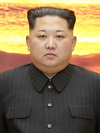Presidium of the Politburo of the Workers' Party of Korea
Presidium of the Political Bureau of the Central Committee of the Workers' Party of Korea 조선로동당중앙위원회정치국상무위원회 | |
|---|---|
 | |
| Leadership | |
Status | Highest body of the Central Committee between sessions, Workers' Party of Korea |
Members | |
Elected by | |
Responsible to | |
| Seats | 5 |
| Presidium of the Politburo of the Workers' Party of Korea | |
| Chosŏn'gŭl | |
|---|---|
| Hancha | |
| Revised Romanization | Joseon Rodongdang Jungang Wiwonhoe Jeongchigung Sangmu Wiwonhoe |
| McCune–Reischauer | Chosŏn Rodongdang Chungang Wiwŏnhoe Chŏngch'igung Sangmu Wiwŏnhoe |
 |
|---|
| |
The Presidium of the Political Bureau of the Workers' Party of Korea, or simply the Presidium, and formerly known as the Standing Committee (1946–61), is a committee consisting of the top leadership of the Workers' Party of Korea. Historically, it has been composed of one to five members, and currently has five members.[1] Its officially mandated purpose is to conduct policy discussions and make decisions on major issues when the Politburo, a larger decision-making body, is not in session. While the Presidium in theory reports to the Politburo, which in turn reports to the larger Central Committee, in practice the Presidium is supreme over its parent bodies and acts as the most powerful decision-making body in North Korea.[1] As North Korea is a one-party state, the Presidium's decisions de facto have the force of law.[2] Its role is roughly analogous to that of the Politburo Standing Committee of the Chinese Communist Party.
History
[edit]The Presidium was revitalized at the 3rd Conference, with four new members appointed: Kim Yong-nam (President of the Presidium of the Supreme People's Assembly, head of state), Choe Yong-rim (Premier, head of government), Vice Marshal Jo Myong-rok (Director of the General Political Bureau of the Korean People's Army) and Vice Marshal Ri Yong-ho (Chief of the General Staff).[3] The appointment of two military officers was considered by outside observers to be in line with Kim Jong Il's military-first politics.[3] It was believed that Ri Yong-ho was Kim Jong Un's personal military escort at the time, similar to O Jin-u's role during Kim Jong Il's early rule.[3] At the 4th Conference, Chasu Choe Ryong-hae was appointed to the Standing Committee.[4]
Current members
[edit]| Member | Member since | Other positions | |
|---|---|---|---|
 | Kim Jong Un 김정은 (born 1984) | 11 April 2012 | |
 | Choe Ryong-hae 최룡해 (born 1950) | 11 April 2012 |
|
| Ri Pyong-chol 리병철 (born 1948) | 13 August 2020 |
| |
 | Kim Tok-hun 김덕훈 (born 1962) | 13 August 2020 | |
| Jo Yong-won 조용원 | 10 January 2021[5] |
| |
References
[edit]Footnotes
[edit]- ^ a b Pinkston, Daniel (30 April 2020). "Leadership, guns, and money in North Korea: what happens if Kim Jong Un goes". NK News. Retrieved 30 April 2020.
- ^ "金正恩が党委員長に就任(名簿)". Phoenix Television. 9 May 2016.
- ^ a b c Gause 2011, p. 148.
- ^ "Kim Jong Un Appointed "First Secretary" of Korean Workers' Party". North Korea Leadership Watch. 11 April 2012. Archived from the original on 13 March 2014. Retrieved 13 March 2014.
- ^ "Press Release of First Plenary Meeting of 8th Central Committee of WPK Issued". KCNA Watch. Retrieved 11 January 2021.
Bibliography
[edit]- Gause, Ken E. (2011). North Korea Under Kim Chong-il: Power, Politics, and Prospects for Change. ABC-CLIO. ISBN 978-0313381751.


 French
French Deutsch
Deutsch